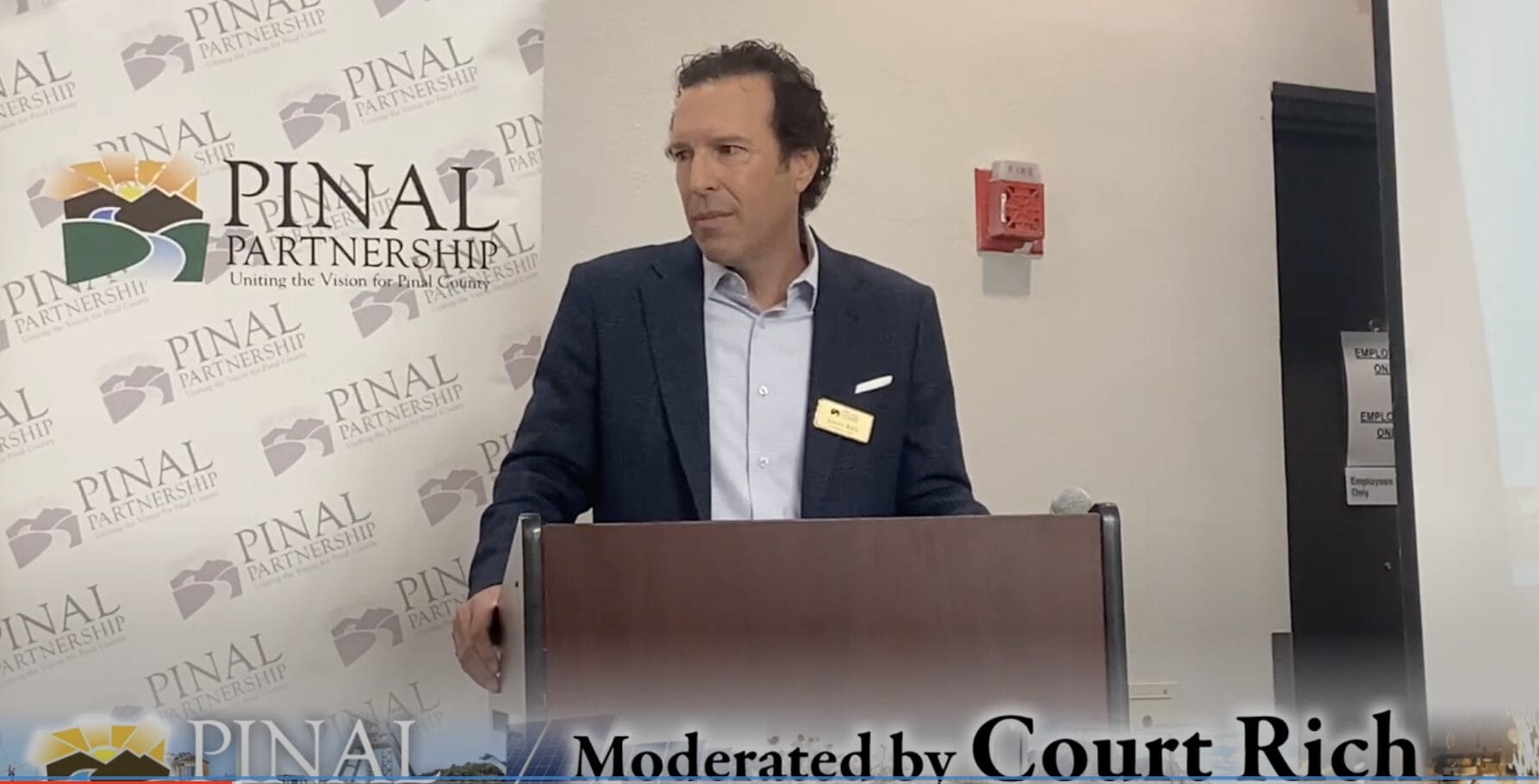By Madelaine Braggs | Rose Law Group Reporter
Pinal County is positioned to reap significant benefits from clean energy development according to state and industry leaders at this month’s Pinal Partnership breakfast.
The event gathered a distinguished panel of experts to discuss the economic and environmental benefits of renewable energy in Pinal County and was moderated by Court Rich, Co-Founder and Director of the Renewable Energy and Utility Infrastructure Department at Rose Law Group.
Panelists included:
- Dr. Greg Barron-Gafford, a professor and Director of Food, Energy, and Water Resilience at Biosphere 2
- Buchanan Davis, Director of Local Relations at Salt River Project (SRP)
- Jim Rounds of Rounds Consulting
- Todd Cooley of Cooley Farms
Economic Opportunities Through Renewable Energy
The discussion kicked off with Jim Rounds, an economist who has been at the forefront of analyzing the economic implications of renewable energy in Arizona. Rounds emphasized that renewable energy, especially solar, is not just about powering homes and businesses—it’s a critical driver of economic development. His recent report estimated a statewide economic impact of $7.3 billion and $150 million in tax revenue, highlighting the transformative potential of solar energy.
Rich echoed Rounds’ enthusiasm for the economic benefits of solar energy. “I’ve spent nearly two decades talking about solar every day, and it’s incredible to see how it’s now recognized as a major economic opportunity,” he remarked. “It’s not just about clean energy; it’s about creating jobs, boosting local economies, and ensuring a sustainable future.”
Pinal County, in particular, stands at the forefront of this transformation. The county is experiencing an upward inflection point, bringing in new businesses and increasing local incomes. Rounds pointed out that solar energy projects are not just isolated installations; they are part of a broader web of economic development. These projects attract businesses involved in research and development (R&D) and manufacturing, further stimulating the local economy.
“The communities that are embracing solar power plants are the ones that will attract the R&D and manufacturing jobs,” Rounds explained. “It’s about the whole continuum of economic development, not just a single solar project.”
SRP’s Role in Powering Growth
Buchanan Davis provided insights from SRP’s perspective, highlighting the utility’s commitment to renewable energy. SRP is aggressively acquiring and developing clean energy projects to meet the growing demand in Arizona, particularly in Pinal County, where some of SRP’s fastest-growing service areas are located. Davis shared that SRP is planning to double, or even triple, its resources in the next decade to keep up with the burgeoning demand.
“SRP is focused on ensuring reliable power for Arizona’s growing communities,” Davis said. “What took us 100 years to build, we now need to do in 10 years.”
Davis also addressed common myths about solar energy, such as the notion that solar fields could cause excessive heat in nearby areas. He referenced research conducted by Dr. Greg Barron-Gafford, which debunked the heat island effect myth, showing that temperature increases are minimal and confined within the solar fields.
“It does increase within the solar field itself, a couple of degrees but this idea of a heat island that is reaching off into neighboring properties is not happening. At all. We’ve measured sites of all different types of sizes, different arrangements, different places around the country.” He says scientific research is often published in the metric system, causing widespread confusion, but while citing his data he emphatically ensured, “We measured every 10 meters, or approximately 30 ft, there’s no detectable increase in temperature.”

Integrating Agriculture and Solar: The Agrivoltaics Revolution
Dr. Barron-Gafford, a leader in the field of agrivoltaics, shared groundbreaking research on integrating agriculture with solar energy production. Agrivoltaics involves the simultaneous use of land for both solar energy generation and agriculture, creating a win-win situation for both energy production and food security.
“This is where innovation meets necessity,” Rich said of the potential. “We’re not just generating electricity; we’re finding ways to support our farmers and make better use of our land. It’s a perfect example of how renewable energy can drive progress in multiple areas.”
Dr. Barron-Gafford’s research has demonstrated that crops can thrive under solar panels, benefiting from the shade provided by the panels, which reduces water evaporation and can even increase crop yields. This innovative approach allows for the dual use of land, addressing the common concern of land competition between solar energy and agriculture.
“We’re not just growing solar panels; we’re growing food,” Dr. Barron-Gafford said. “Agrivoltaics allows us to harvest the sun twice—once for energy and once for food.”
This research is particularly relevant in Pinal County, where water scarcity is a significant concern for farmers. By integrating solar panels with crops, farmers can reduce water usage and continue farming even in the face of decreasing water availability.
The Farmer’s Perspective: Balancing Economics and Sustainability
Todd Cooley, a farmer in Pinal County, provided a firsthand account of the challenges and opportunities presented by solar energy development. Cooley’s farm has been affected by water shortages, leading him to explore alternative land uses, such as leasing land for solar energy production. Cooley explained that 50% of farm land is being fallowed each year because of water shortages making solar uses a way to utilize land that would otherwise sit bare.
Cooley noted, “with 50% less water available, it’s tough to make farming economically viable.”
Cooley said he was driven by the need to adapt to changing environmental conditions and ensure the long-term sustainability of his farming operations. He emphasized that solar energy and farming can coexist, and in many cases, they complement each other.
“We don’t have to choose between solar and farming,” Cooley said. “They can work together to benefit both the environment and the economy.”
Addressing Myths and Concerns: A Path Forward
Throughout the discussion, the panel took the opportunity to address several common myths and concerns related to solar energy development. One of the recurring myths is that solar projects negatively impact property values and the local environment. However, research and real-world examples presented during the event showed that solar projects can coexist with local communities and even provide additional benefits, such as increased tax revenue for schools and other public services.
Another concern is the potential environmental impact of solar projects, including the alleged leaching of chemicals into the soil. Dr. Barron-Gafford reassured the audience that rigorous testing is conducted to ensure the safety of crops grown under solar panels, and no evidence of contamination has been found. He told a story about working with a local farmer to take samples inside solar sites and on local farms. They found no contamination. To underscore this point, he reported his team regularly eats the produce they grow directly under the panels.
The discussion also touched on the perception that Pinal County is being disproportionately targeted for solar development. Buchanan Davis clarified that solar projects are being developed across Arizona, not just in Pinal County. The county’s existing infrastructure, available land, and growing demand make it an ideal location for these projects.
“We’re seeing solar development everywhere, but Pinal County is uniquely positioned to take advantage of this growth because of its infrastructure and forward-thinking policies,” Rich said.
The Importance of Community Engagement
Throughout the discussion, the experts underscored the importance of community engagement and education. They emphasized that addressing myths and misinformation is crucial to gaining community support for renewable energy projects. To aid the effort, the Pinal Partnership’s Renewable Energy Committee has developed a “MythBusters” slide deck to provide accurate information and resources for policymakers and community members.
“Engaging the community and providing them with the facts is key,” Rich said. “We want to ensure that everyone understands the real benefits of renewable energy and that we’re all working together to build a better future.”
The panelists also highlighted the role of local governments in facilitating the growth of renewable energy. By creating supportive policies and collaborating with developers, local governments can ensure that their communities reap the economic and environmental benefits of renewable energy.

A Bright Future for Pinal County
The Pinal Partnership Breakfast served as a testament to the growing importance of renewable energy in Arizona’s economic and environmental landscape.
As the state continues to embrace renewable energy, the lessons learned in Pinal County will be invaluable. By addressing myths, integrating innovative approaches like agrivoltaics, and fostering collaboration between communities, governments, and businesses, Arizona can lead the way in building a more sustainable and prosperous future.
“We’re at a critical juncture,” Rich concluded. “The decisions we make now will determine whether we continue to lead in renewable energy and economic development. Pinal County is ready to seize this opportunity and set an example for the rest of the state.”










